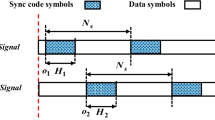Abstract
The Sequential Estimation (SE) technique introduced by Ward was designed for the acquisition of pseudo-noise (PN) signals. It proves to be an effective model in medium SNRs as long as inverted PN sequences are not encountered. Recognizing that negative data bits invert PN sequences in spread spectrum transmissions, Chiu and Lee developed an Improved Sequential Estimator (ISE) that processes both types of sequences. The ISE design, however, erroneously despreads the incoming signal by inverting it during negative bit acquisitions. In some applications, this could be a problem, hence a Dual Correlating Sequential Estimator (DCSE) is proposed in this paper. The DCSE detects modulation errors by gathering correlation measurements from resident SE and ISE subsystems and corrects for them with an inverting mechanism. Key performance parameters such as mean timing and the variance of acquisition for the sequential estimator designs are derived via the generalized signal flow graph method and verified through simulation. In an additive White Gaussian noise (AWGN) environment, the DCSE design is shown to outperform the SE for every tested signal-to-noise ratio (SNR).
Similar content being viewed by others
Abbreviations
- SE:
-
sequential estimation
- PN:
-
pseudo-noise
- ISE:
-
improved sequential estimator
- DCSE:
-
dual correlating sequential estimator
- AWGN:
-
additive white gaussian noise
- SNR:
-
signal-to-noise ratio
References
R.B. Ward. “Acquisition of pseudo-noise signals by sequential estimation.” IEEE Transactions on Communications vol COM-13, No. 4, pp. 474–48, 1965.
R. L. Pickholtz, D. L. Schilling and L. B. Milstein. “Theory of spread-spectrum communications — A tutorial. IEEE Transactions on Communications vol COM-30, No. 5, pp. 855–884, 1982.
J. H. Chiu and L. S. Lee. “An improved sequential estimation scheme for PN acquisition.” IEEE Transactions on Communications, vol 36, No. 10, pp. 1182–1184, 1988.
J. K. Holmes and C. C. Chen. “Acquisition time performance of PN spread-spectrum systems.” IEEE Transactions on Communications vol. COM-25, No. 8, pp. 778–784, 1977.
J. K. Holmes. “Coherent spread spectrum systems.” John Wiley & Sons, New York, 1982.
R.E. Ziemer and R. L. Peterson. “Digital communications and spread spectrum systems.” Macmillan Publishing Co., New York, 1985.
R. C. Dixon. “Spread spectrum systems.” Second edition, John Wiley & Sons, New York, 1984.
G. G. Koller. “Rapid coarse acquisition techniques for direct sequence spread spectrum communications.” Ph.D dissertation, University of Central Florida, Orlando FL, 1993.
Author information
Authors and Affiliations
Rights and permissions
About this article
Cite this article
Koller, G.G., Belkerdid, M.A. Performance of sequential estimation for direct sequence spread spectrum code acquisition. Wireless Pers Commun 1, 103–110 (1994). https://doi.org/10.1007/BF01098687
Issue Date:
DOI: https://doi.org/10.1007/BF01098687




